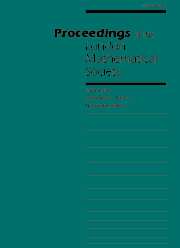Crossref Citations
This article has been cited by the following publications. This list is generated based on data provided by
Crossref.
Hersonsky, S.
and
Paulin, F.
2001.
Hausdorff dimension of diophantine geodesics in negatively curved manifolds.
Journal für die reine und angewandte Mathematik (Crelles Journal),
Vol. 2001,
Issue. 539,
Dodson, Maurice
2002.
Rigidity in Dynamics and Geometry.
p.
77.
Druţu, Cornelia
2005.
Diophantine approximation on rational quadrics.
Mathematische Annalen,
Vol. 333,
Issue. 2,
p.
405.
Stratmann, Bernd O.
2006.
Non-Euclidean Geometries.
Vol. 581,
Issue. ,
p.
227.
KESSEBÖHMER, MARC
and
STRATMANN, BERND O.
2009.
Hölder-differentiability of Gibbs distribution functions.
Mathematical Proceedings of the Cambridge Philosophical Society,
Vol. 147,
Issue. 2,
p.
489.
Parkkonen, Jouni
and
Paulin, Frédéric
2010.
Prescribing the behaviour of geodesics in negative curvature.
Geometry & Topology,
Vol. 14,
Issue. 1,
p.
277.
Barral, Julien
and
Seuret, Stéphane
2011.
A localized Jarník–Besicovitch theorem.
Advances in Mathematics,
Vol. 226,
Issue. 4,
p.
3191.
Denker, Manfred
and
Stratmann, Bernd O.
2012.
Contributions in Analytic and Algebraic Number Theory.
Vol. 9,
Issue. ,
p.
171.
Munday, Sara
2012.
On Hausdorff dimension and cusp excursions for Fuchsian groups.
Discrete & Continuous Dynamical Systems - A,
Vol. 32,
Issue. 7,
p.
2503.
Mayeda, Dustin
and
Merrill, Keith
2013.
Limit points badly approximable by horoballs.
Geometriae Dedicata,
Vol. 163,
Issue. 1,
p.
127.
FISHMAN, LIOR
MANCE, BILL
SIMMONS, DAVID
and
URBAŃSKI, MARIUSZ
2015.
SHRINKING TARGETS FOR NONAUTONOMOUS DYNAMICAL SYSTEMS CORRESPONDING TO CANTOR SERIES EXPANSIONS.
Bulletin of the Australian Mathematical Society,
Vol. 92,
Issue. 2,
p.
205.
Kleinbock, Dmitry
and
Merrill, Keith
2015.
Rational approximation on spheres.
Israel Journal of Mathematics,
Vol. 209,
Issue. 1,
p.
293.
Wang, Baowei
and
Wu, Jun
2017.
Recent Developments in Fractals and Related Fields.
p.
261.
Beresnevich, Victor
Ghosh, Anish
Simmons, David
and
Velani, Sanju
2018.
Diophantine approximation in Kleinian groups: singular, extremal, and bad limit points.
Journal of the London Mathematical Society,
Vol. 98,
Issue. 2,
p.
306.
Edwards, Samuel C
2022.
Effective Equidistribution of the Horocycle Flow on Geometrically Finite Hyperbolic Surfaces.
International Mathematics Research Notices,
Vol. 2022,
Issue. 6,
p.
4040.
Shen, Zhipeng
2023.
Modified shrinking target problems on self-conformal sets.
Journal of Mathematical Analysis and Applications,
Vol. 517,
Issue. 2,
p.
126659.
Bandi, Prasuna
Ghosh, Anish
and
Nandi, Debanjan
2023.
Exact approximation order and well-distributed sets.
Advances in Mathematics,
Vol. 414,
Issue. ,
p.
108871.
Barral, Julien
and
Seuret, Stéphane
2023.
The Frisch-Parisi conjecture I: Prescribed multifractal behavior, and a partial solution.
Journal de Mathématiques Pures et Appliquées,
Vol. 175,
Issue. ,
p.
76.
TAMAM, NATTALIE
and
WARREN, JACQUELINE M.
2023.
Effective equidistribution of horospherical flows in infinite volume rank-one homogeneous spaces.
Ergodic Theory and Dynamical Systems,
Vol. 43,
Issue. 8,
p.
2780.
Lin, Xiaojun
Ma, Dongkui
Ye, Xiaojiang
and
Tang, Yanjie
2024.
The entropy formula of shrinking target problem in nonautonomous dynamical systems.
Dynamical Systems,
Vol. 39,
Issue. 3,
p.
547.


